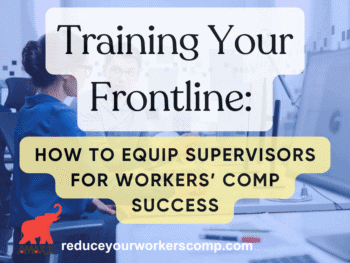
Countless studies indicate that a timely response to a work injury reduces workers’ compensation program costs. One tool can be used to create an injury response coordinator within an employer. This person can ensure that all steps are complete and nothing is missed.
There is no specific template for this position. An effective injury response coordinator should be able to influence all levels of a business and effectuate change for the better. Roles for this position include:
- Oversee and supervise the workplace response to an injury at all levels;
- Prepare materials that describe the workers’ compensation claim process and define available benefits;
- Identify troublesome claims and coordinate efforts with members of the claim management team; and
- Identify financial issues related to the workers’ compensation program, including insurance coverage, deductible amounts, and who pays for self-insured and high retention policies.
If applicable, an injury response coordinator can also serve as a liaison between the employer and a labor union. This coordinator needs to be driven and highly motivated to solve problems.
Click Link to Access Free PDF Download
“9-Element Blueprint To Create Your Workers’ Comp Employee Brochure”
Create an Injury Response Coordinator Position
Supervisor Engagement Required
Any supervisor with an injured employee needs to be engaged in the injury response and return to work process. This is important as this can be someone whom the employee trusts. A supervisor will also have important information regarding the employee’s job duties, habits, and information concerning their willingness to get back to work.
There are other areas where a supervisor is required to participate in an effective injury response:
- Assist the employee with medical care and make sure they receive it promptly. This goes beyond being trained in basic first aid;
- Able to understand and follows policies and procedures related to workplace safety;
- Able to assist the employee in reporting the work injury and ensure all information collected is accurate; and
- Ensure work restrictions are received and communicated with all interested stakeholders.
Having a supervisor willing to drive an injured employee to a doctor’s office or visit them in the hospital builds trust and increases workplace morale. Consider having this person send a “get well card” following any injury.
Communicate, Communicate, Communicate!
Effective communication following a work injury is necessary for all instances. There is a lot of information each party has to share. Failure to collect this information can result in delay and a prolonged return to work.
- Ensure the employee provides all necessary and relevant information. Interested stakeholders on the claim side need to make sure the employee has the means to communicate. Things to consider should include telephonic and web-based portals to provide information. Consider adding telephone language translation services.
- Ensure the employer provides consistent and accurate information to the employee and the claiming team. This is another role where an injury response coordinator can add value to the claims process.
Communication is also essential when returning to work after an injury. All employers should consider adding a specific coordinator for these efforts or including it in the role of the Injury Response Coordinator. Items to consider in return to work include:
- The nature and length of transitional job assignments open to employees injured on the job;
- Information concerning the mode in which a transitional job program will be offered following an injury; and
- Benchmarks must be met before an employee can return to their regular position.
Setting expectations concerning return to work assignments from the onset reduces confusion and provides a goal for an employee to achieve. It also helps reduce program costs and promotes efficiencies with a workers’ compensation program.
Conclusions
Now is the time for interested stakeholders to review their workers’ compensation programs and focus on their post-injury responses. This includes the need for employers to determine if there is a benefit to having an injury coordinator work closely with the claiming team. There also needs to be an effort to have the supervisor become more engaged and communicate effectively. A more streamlined post-injury response can improve any workers’ compensation program and promote settlement.
 Author Michael Stack, CEO Amaxx LLC. He is an expert in workers’ compensation cost containment systems and helps employers reduce their workers’ comp costs by 20% to 50%. He works as a consultant to large and mid-market clients, is a co-author of Your Ultimate Guide To Mastering Workers Comp Costs, a comprehensive step-by-step manual of cost containment strategies based on hands-on field experience, and is the founder & lead trainer of Amaxx Workers’ Comp Training Center, which offers the Certified Master of Workers’ Compensation national designation.
Author Michael Stack, CEO Amaxx LLC. He is an expert in workers’ compensation cost containment systems and helps employers reduce their workers’ comp costs by 20% to 50%. He works as a consultant to large and mid-market clients, is a co-author of Your Ultimate Guide To Mastering Workers Comp Costs, a comprehensive step-by-step manual of cost containment strategies based on hands-on field experience, and is the founder & lead trainer of Amaxx Workers’ Comp Training Center, which offers the Certified Master of Workers’ Compensation national designation.
Contact: mstack@reduceyourworkerscomp.com.
Workers’ Comp Roundup Blog: http://blog.reduceyourworkerscomp.com/
©2022 Amaxx LLC. All rights reserved under International Copyright Law.
Do not use this information without independent verification. All state laws vary. You should consult with your insurance broker, attorney, or qualified professional.

















